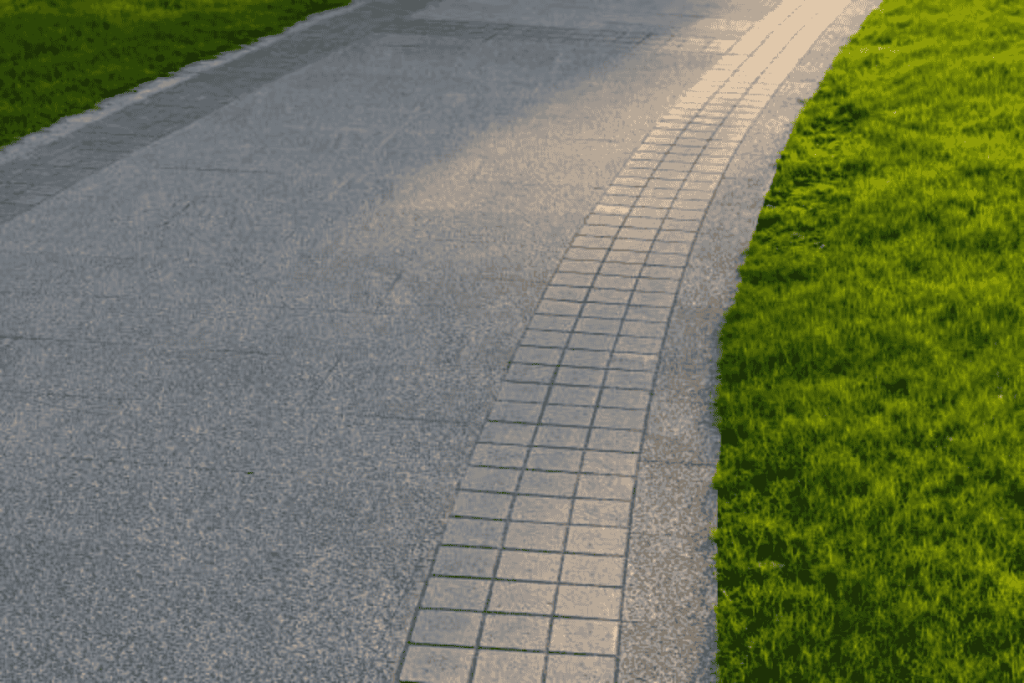When it comes to sidewalk construction or repair, property owners often ask, how wide is a sidewalk? The answer depends on several factors, including local regulations, foot traffic, and accessibility requirements. In this article, we’ll explore the standard dimensions of sidewalks and help you understand how wide is a sidewalk in different areas like NYC, Westchester, and Long Island.
Table of Contents
At Liberty General Contracting, we’ve been building, repairing, and maintaining sidewalks across New York for years. Whether it’s residential or commercial, the width of a sidewalk depends on various factors, including location, safety regulations, and building codes. This guide explores the typical sidewalk dimensions, compliance with ADA guidelines, and why sidewalk width matters in different settings.
The Importance of Sidewalk Width in Urban Areas
Sidewalks may seem like simple structures, but they play a significant role in ensuring safety, comfort, and accessibility for pedestrians. When determining the right width of a sidewalk, several factors need to be considered, especially in a bustling urban environment like NYC. Here’s why sidewalk dimensions matter:
Safety and Comfort
A sidewalk needs to provide enough space for pedestrians to walk without feeling cramped. Narrow sidewalks increase the risk of accidents and create discomfort for pedestrians, especially in high-traffic areas. Proper sidewalk width reduces pedestrian crowding, allowing enough room for people to walk side by side.
Accessibility
For people with disabilities, an adequately wide sidewalk is critical. The Americans with Disabilities Act (ADA) sets guidelines to ensure that sidewalks are accessible to everyone, including individuals who use wheelchairs, strollers, or other mobility aids.
Compliance with Local Codes
In cities like NYC, sidewalks are regulated by local government bodies, like the Department of Transportation (DOT). These regulations ensure that sidewalks meet safety and accessibility standards, especially in commercial zones.
How Wide Is a Sidewalk in NYC? Understanding the Standards

Standard Sidewalk Dimensions for Residential Areas
In residential areas throughout New York, the typical sidewalk width is 4 to 5 feet. This is wide enough for a pedestrian to walk comfortably. However, some neighborhoods may have narrower sidewalks, especially in older residential districts.
- 4 feet: This is the minimum sidewalk width allowed for pedestrian traffic. It’s narrow but still sufficient for individuals to walk alone.
- 5 feet: This is the preferred width for residential sidewalks, allowing two pedestrians to walk side by side comfortably.
In suburban neighborhoods like Westchester or Long Island, sidewalks often measure closer to 5 feet due to less congestion compared to NYC.
Commercial Sidewalks in Urban Districts
Sidewalks in commercial areas need to accommodate a higher volume of foot traffic. As such, their width is usually greater. For instance, in Manhattan’s busy shopping districts, sidewalk width increases significantly to accommodate tourists, shoppers, and local workers.
- 6 to 8 feet: Typically found in small commercial zones or less crowded streets. This allows for moderate foot traffic without blocking the sidewalk.
- 10 to 12 feet: Common in high-traffic commercial districts, such as near Times Square or other iconic NYC locations.
- 15 feet or more: In extremely busy areas, such as near major subway stations, stadiums, or parks, sidewalks can be as wide as 15 feet to handle crowds.
As you can see, the width of average sidewalks in NYC commercial areas can be far larger than residential sidewalks. It’s crucial to accommodate foot traffic while maintaining safety and accessibility.
ADA Guidelines and Compliance for Sidewalks
One of the most important considerations when determining sidewalk width is compliance with the Americans with Disabilities Act (ADA). The ADA ensures that sidewalks are accessible to all people, including those with mobility challenges.
Minimum Width Requirement
Under the ADA, sidewalks must be a minimum of 5 feet wide to allow wheelchair users and people with strollers to pass easily. In some cases, 5×5-foot passing spaces are required when sidewalks are narrower than 5 feet, ensuring people can pass each other comfortably.
At Liberty General Contracting, all of our sidewalk installations and repairs are fully ADA-compliant, so you don’t have to worry about accessibility issues down the line.
How Sidewalk Width Is Affected by Location
The average width of a sidewalk varies depending on the neighborhood and the volume of pedestrian traffic. Factors like population density, proximity to public transport, and available space in urban planning determine the sidewalk’s size.
Residential vs Commercial Zones
- Residential Areas (4–5 feet): Ideal for neighborhoods with less foot traffic. Sidewalks here serve as safe paths for homeowners and pedestrians to walk to and from their houses.
- Commercial Areas (6–12 feet): Businesses require more space for people to move around. These areas often have wider sidewalks to accommodate both pedestrians and street vendors, especially in areas with heavy foot traffic.
- High-Density Urban Zones (10–15 feet): Sidewalks in areas like Manhattan may need to be wider to handle the high volume of pedestrians.
How to Design or Renovate Sidewalks for NYC, Westchester, and Long Island
If you are planning a sidewalk installation or sidewalk repair in NYC, Westchester, or Long Island, it’s important to follow these guidelines for a successful and code-compliant project. Here’s what you need to keep in mind:
Step 1: Determine the Sidewalk’s Purpose
Is the sidewalk residential or commercial? Will it be in a high-traffic area? Understanding its purpose will help you determine the appropriate sidewalk width and materials.
Step 2: Compliance with ADA Standards
All newly constructed sidewalks in NYC, Westchester, and Long Island must be ADA-compliant. This ensures that the sidewalk is wide enough for wheelchairs, strollers, and other mobility devices.
Step 3: Factor in Safety
Sidewalks must be wide enough to allow pedestrians to walk safely without feeling cramped. Incorporating buffer zones between the road and sidewalk, such as tree pits or grass strips, also enhances safety by reducing the risk of accidents.
Step 4: Material Selection and Durability
For durability, sidewalks in NYC must be made from strong materials, such as concrete or asphalt. Concrete sidewalks last longer and require less maintenance, which is important in a city like NYC where sidewalks are constantly subjected to weather and traffic.
Sidewalks and Property Value in NYC, Westchester, and Long Island
Aside from the obvious functional purposes, sidewalks can also add value to your property. A well-maintained sidewalk improves curb appeal, enhances the aesthetic of your street, and can even help attract future buyers if you’re looking to sell. Property owners in Westchester and Long Island often find that investing in quality sidewalk construction or repairs increases the overall market value of their homes or businesses.
At Liberty General Contracting, we work closely with property owners to ensure that their sidewalks enhance the value and safety of their property. Whether you need sidewalk repairs or a completely new installation, we have you covered.
The Legal Side of Sidewalk Construction and Maintenance
In NYC, property owners are responsible for maintaining sidewalks in front of their properties. This means that if your sidewalk is damaged, you could face fines or a DOT violation if it’s not repaired. At Liberty General Contracting, we assist with DOT violation removal and provide expert sidewalk repair services that meet city standards.
FAQs: How Wide Is a Sidewalk?
1. How wide is a sidewalk in NYC?
In New York City, the width of a sidewalk varies depending on the location. Residential sidewalks typically measure between 4 to 5 feet wide, while commercial and high-traffic areas, like Manhattan, may have sidewalks ranging from 6 to 12 feet or even 15 feet in busier districts.
2. What is the standard width for a sidewalk?
The standard sidewalk width in most areas is 5 feet. This width is often recommended to ensure both comfort and safety for pedestrians. However, the exact width can vary depending on whether the sidewalk is residential, commercial, or in a high-density urban area.
3. How wide is a sidewalk in residential neighborhoods?
In residential areas, sidewalks typically measure around 4 to 5 feet wide. This allows pedestrians to move safely, while also providing enough space for small street furniture or greenery without taking up too much of the roadway.
4. How wide are sidewalks in commercial zones?
Sidewalks in commercial zones are generally 6 to 12 feet wide, depending on pedestrian traffic. Areas with high foot traffic, such as Manhattan, may require sidewalks as wide as 15 feet to accommodate crowds.
5. How wide does a sidewalk need to be for ADA compliance?
According to ADA standards, sidewalks must be at least 5 feet wide to accommodate wheelchairs and other mobility aids. For narrower sidewalks, additional passing spaces are required every 200 feet to ensure accessibility.
6. How wide is a sidewalk in high-traffic areas like Times Square?
In extremely high-traffic areas, such as Times Square, sidewalks are much wider. Sidewalks in these zones can range from 10 to 15 feet to manage the large number of pedestrians that pass through these locations daily.
7. Can a sidewalk be too wide?
While sidewalks need to be wide enough to accommodate pedestrians safely, sidewalks that are too wide in residential areas can take up valuable space that could otherwise be used for landscaping or parking. It’s important to follow local regulations to ensure sidewalks are functional without being excessively wide.
Final Thoughts: How Wide Is a Sidewalk?
So, how wide is a sidewalk in New York City, Westchester, and Long Island? The answer depends on where you are, the amount of foot traffic, and the type of property:
- Residential sidewalks: 4–5 feet
- Commercial sidewalks: 6–12 feet
- Busy urban areas: 10–15 feet
- ADA-compliant sidewalks: At least 5 feet wide
At Liberty General Contracting, we specialize in sidewalk installation, repairs, and DOT violation removals. We help property owners in NYC, Westchester, and Long Island build durable, safe, and accessible sidewalks that meet all local and federal regulations. Whether you need a simple repair or a complete installation, our team is here to help you every step of the way.
Contact Liberty GCNY
Website: www.libertygcny.com
Phone: (347) 682-9840
Serving: Manhattan, Brooklyn, Queens, The Bronx, Westchester County, and Long Island.
Address:110-14 178th St, Jamaica, NY
Need Help with Your Next Project? Call Liberty GCNY Today!
Fast responses. Expert advice. Trusted service across NYC and beyond.


